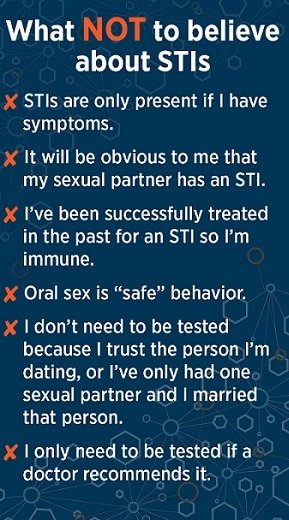
There appears to be an increase in high-risk behaviors among service members
By Military Health System Communication Office
The rates of certain types of sexually transmitted infections, or STIs, are rising dramatically for both male and female service members, according to a recent report. These STIs include chlamydia, gonorrhea, and syphilis. Data from the Centers for Disease Control and Prevention confirm similar surges for these three types of infections in the civilian population. The current high rates in the military pose challenges for more than 1.3 million DoD personnel, 84 percent of whom are men.
“We have a large number of males in the service, and the population we see normally is the 18 to 25 year olds. STI is most common in that age group,” said Norma Jean Suarez, a nurse practitioner in preventive medicine at Brook Army Medical Center in San Antonio. She added that the men she sees often don’t know how prevalent STIs are.
“STIs place a significant economic strain on the U.S. and military health care systems,” said Maj. Dianne Frankel, an Air Force internal medicine physician and USU preventive medicine resident. In 2012, STIs in the Navy alone accounted for health care costs of $5.4 million.
“From a military standpoint, STIs can have a significant impact on individual readiness, which in turn impacts unit readiness, which then leads to a decrease in force health protection,” said Frankel. She added that there can be serious health consequences for untreated STIs, including, down the road, cancer in the case of genital human papillomavirus, or HPV.
But why are STIs on the rise, and why now? “There appears to be an increase in high-risk behaviors among service members; that is, having sex without a condom or having more than one sexual partner,” said Frankel, referring to the 2015 DoD Health-Related Behaviors Survey, known as HRBS. This report documented that one-fifth of respondents reported having more than one sexual partner in the past year, while one-third reported having sex with a new partner in the past year without use of a condom. These numbers have doubled since the last reported survey in 2011, said Frankel.
Suarez added another factor she’s been seeing: Dating apps can promote random, anonymous encounters, and when infections result, that anonymity can make partners difficult to track down. Having anonymous sex is one of the CDC’s list of behaviors that can increase risk of contracting an STI or HIV. Others include having vaginal, oral, or anal sex without a condom; having multiple sexual partners; or having sex while under the influence of drugs or alcohol, which can lower inhibitions and result in greater sexual risk-taking.
In general, STIs spread readily if precautions aren’t taken, according to Col. Amy Costello, chief of preventive medicine at the Air Force Medical Support Agency. “Chlamydia and gonorrhea are quite common; they can be transmitted vaginally, anally, or through oral-sexual contact,” she said. “Pretty much any time you have mucous membrane contact with an infected person, you have a chance of getting it.” She added that syphilis is usually spread through open sores that can be non-painful, meaning an infected person might not know the infection is present.
Not all STIs are on the rise, according to the HRBS. Rates for genital herpes simplex decreased slightly between 2010 and 2018, and HPV dropped by almost 52 percent. She credited the widespread adoption of the HPV vaccine for the dramatic decline in the rate of infection.
HIV is another STI of concern. “A lot of service members don’t understand that HIV exists on the active-duty military side,” said Suarez. “Here in San Antonio alone, we manage 30+ HIV-positive active-duty soldiers.” But rates of HIV are much lower in the military than in the U.S. population, Frankel said, adding that numbers for HIV from 2012 – 2017 “have been relatively stable.”
Costello said that chlamydia, gonorrhea, and syphilis are bacterial infections that are treated with antibiotics. HPV, herpes, and HIV are viruses and more difficult to treat. She said the most reliable way to avoid getting an STI is to stay away from oral, vaginal, and anal sex unless in a long-term, mutually monogamous relationship with a partner known to be uninfected. But, she added, “That’s not a realistic plan for many of our younger service members who aren’t yet married or in long-term monogamous relationships.” Therefore, condom use is critical, she concluded, and any symptoms should lead to testing.
Efforts are ongoing to combat the rise of STIs through education. “STIs are preventable,” said Frankel. “It’s important for everyone to know how to protect themselves and their partners.”

Carol graduated from Riverside White Cross School of Nursing in Columbus, Ohio and received her diploma as a registered nurse. She attended Bowling Green State University where she received a Bachelor of Arts Degree in History and Literature. She attended the University of Toledo, College of Nursing, and received a Master’s of Nursing Science Degree as an Educator.
She has traveled extensively, is a photographer, and writes on medical issues. Carol has three children RJ, Katherine, and Stephen – one daughter-in-law; Katie – two granddaughters; Isabella Marianna and Zoe Olivia – and one grandson, Alexander Paul. She also shares her life with her husband Gordon Duff, many cats, and two rescues.
ATTENTION READERS
We See The World From All Sides and Want YOU To Be Fully InformedIn fact, intentional disinformation is a disgraceful scourge in media today. So to assuage any possible errant incorrect information posted herein, we strongly encourage you to seek corroboration from other non-VT sources before forming an educated opinion.
About VT - Policies & Disclosures - Comment Policy



